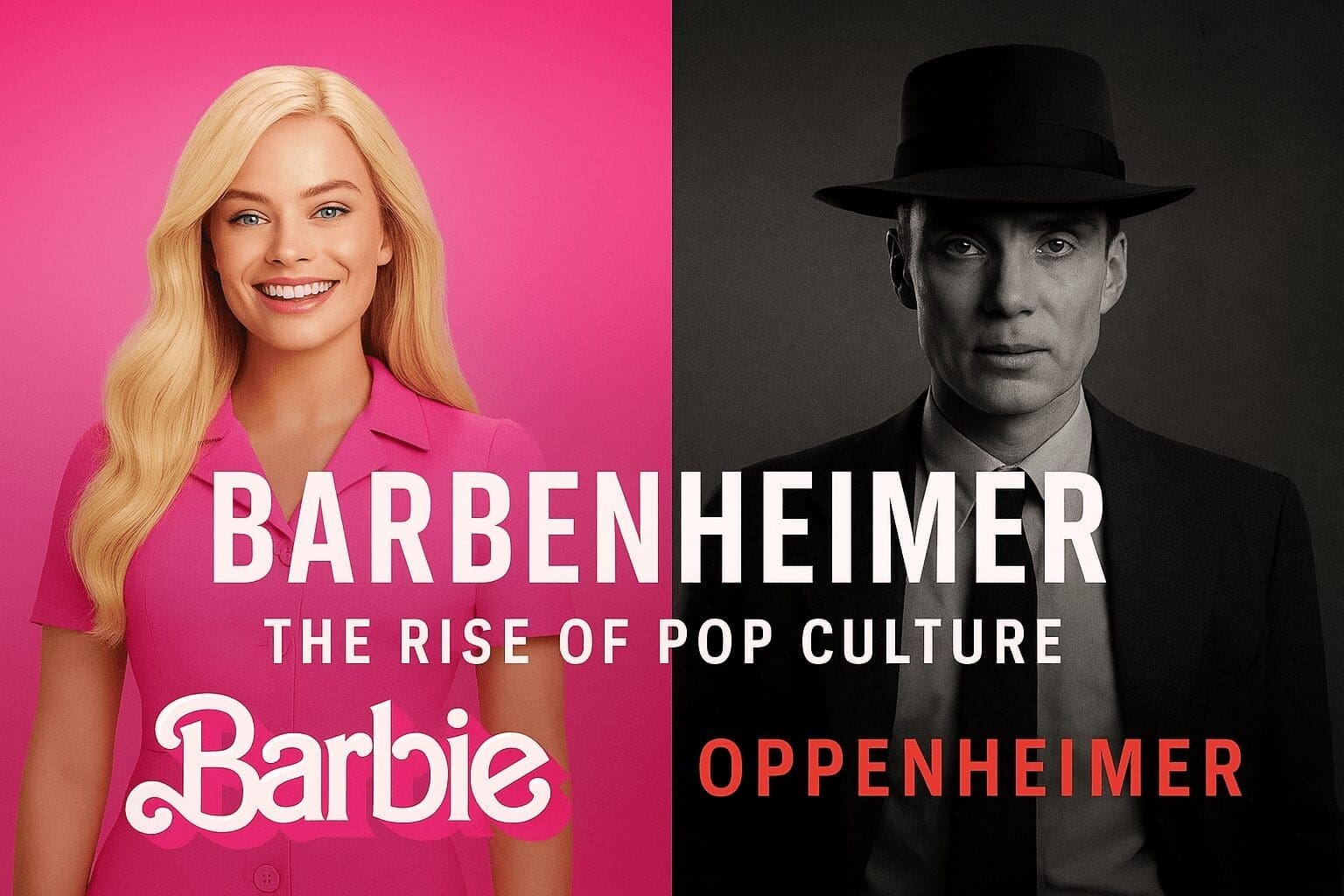What do a neon-pink plastic doll and a gripping three-hour nuclear biopic have in common? In summer 2023, the Barbenheimer trend. A mashup of Barbie and Oppenheimer exploded into one of the decade’s most unforgettable pop culture moments. At first glance, the pairing seems absurd, even “dumb,” but that’s exactly what made it brilliant: it was a perfect example of today’s smart dumb culture, where humor, irony, and spectacle collide to create shared cultural experiences.
What began as a niche meme quickly evolved into a full-blown cinematic event that revived the thrill of the theater, sparking debates, viral fan art, and record-breaking ticket sales. Two movies with wildly different vibes, one candy-colored satire, one tense historical drama, didn’t clash; they complemented each other, proving that pop culture thrives when it’s unpredictable, inclusive, and a little bit absurd.
The Barbenheimer Phenomenon

On July 21, 2023, Greta Gerwig’s Barbie and Christopher Nolan’s Oppenheimer premiered on the same day, igniting what became the Barbenheimer craze. Just as historical events can be reimagined and go viral in today’s digital age, this unique pairing became a cultural phenomenon that captivated audiences worldwide.
One was a candy-colored satire exploring feminism and identity; the other, a tense historical drama about the father of the atomic bomb. On paper, they couldn’t have been more different, but instead of clashing, the films created a cultural and box office synergy.
In this movie hyped phenomenon, over 20,000 loyal AMC moviegoers, members of the theater’s rewards program called AMC Stubs, had already booked a same-day double feature before the release weekend, and that number only kept climbing.
Fans turned the pairing into an event: pink outfits for Barbie, somber black suits for Oppenheimer, carefully timed screenings, and countless social media posts celebrating the contrast.
The results spoke for themselves. Barbie went on to gross over $1.4 billion worldwide, making it the highest-grossing film of 2023, while Oppenheimer earned nearly $950 million, extraordinary numbers for an R-rated historical drama. Together, they proved that “event cinema” is not only alive but thriving in the age of streaming.
Barbie: A Satirical Journey from Plastic to the Real World

Directed by Greta Gerwig, Barbie (2023) stars Margot Robbie as Barbie and Ryan Gosling as Ken in a vibrant, playful yet unexpectedly profound take on the iconic doll’s universe. The film kicks off in the seemingly perfect world of Barbie Land, where Barbie and Ken are living their best lives.
However, when they venture into the outside, “real” world, they discover that life is far more complicated and nuanced than their plastic paradise.
Barbie resonated culturally because it cleverly combined humor and nostalgia with deeper themes of feminism and identity. Showing that even a seemingly lighthearted movie can spark meaningful conversations. Perfectly exemplifying the smart dumb culture that made Barbenheimer so captivating.
Plot Overview:
Barbie, experiencing an existential crisis, ventures into the real world to understand the challenges faced by women. This journey becomes a comedic yet poignant exploration of identity, societal expectations, and self-discovery.
Accolades:
- Nominated for eight Academy Awards, including Best Picture, and won Best Original Song for “What Was I Made For?”.
- Named one of the Top Ten Films of 2023 by the National Board of Review and the American Film Institute.
Where to Watch:
As of now, Barbie is available for streaming on:
- HBO Max (subscription required)
- YouTube (Primetime subscription)
- Hulu (Premium subscription)
- Sling TV (Premium subscription)
- The Roku Channel (Premium subscription)
- Amazon Prime Video (Premium subscription)
- YouTube TV (Premium subscription)
- Fandango at Home
- Google Play Movies & TV
- Apple TV
*Please note that availability may vary based on your region and subscription plans.
Oppenheimer: Exploring Science, Morality, and Legacy

Directed by Christopher Nolan, Oppenheimer (2023) is a gripping, non-traditional biographical thriller starring Cillian Murphy as J. Robert Oppenheimer. The film traces his journey from academic promise to the weighty responsibilities of leading the Manhattan Project during World War II.
While Barbie explores identity and societal expectations with humor and color, Oppenheimer plunges audiences into the gravitas of moral and historical consequences. Creating a stark contrast that became central to the Barbenheimer phenomenon. This juxtaposition of playful satire and ethical intensity is what made the dual viewing experience both thrilling and culturally resonant.
Plot Overview:
The film chronicles Oppenheimer’s journey from his academic pursuits to his leadership of the Manhattan Project, culminating in the Trinity test, the first successful detonation of a nuclear weapon. It explores the profound ethical dilemmas faced by Oppenheimer and his team, as well as the political and personal repercussions that followed.
Accolades:
- Won seven Academy Awards, including Best Picture, Best Director (Christopher Nolan), Best Actor (Cillian Murphy), and Best Supporting Actor (Robert Downey Jr.)
- Received five Golden Globe Awards, including Best Motion Picture – Drama.
- Named one of the Top Ten Films of 2023 by the National Board of Review and the American Film Institute.
Where to Watch:
As of now, Oppenheimer is available for streaming on:
- Peacock (subscription required)
- Amazon Prime Video
- Google Play Movies & TV
- Apple TV
- Fandango at Home
*Please note that availability may vary based on your region and subscription plans.
What Made Barbenheimer Click With Fans

The unprecedented success of the Barbenheimer trend wasn’t just luck; it was the perfect storm of humor, community, and nostalgia. Here’s why this unique cultural moment resonated so strongly with audiences around the world:
Contrast Creates Comedy
The striking difference between Barbie’s playful, colorful world and Oppenheimer’s serious, weighty narrative sets the stage for unexpected humor. This contrast invites audiences to engage with both films individually and as part of a larger cultural conversation. It highlights how opposites can coexist and even enhance each other.
It challenges viewers to shift emotional gears quickly, making the moviegoing experience feel dynamic and lively rather than one-dimensional. This interplay also reflects how today’s audiences appreciate multifaceted entertainment that embraces complexity and irony.
Community Participation
The Barbenheimer craze became more than just watching two films; it evolved into a social movement where fans actively shaped the experience. From coordinating outfits to planning meetups and sharing personal stories about why they loved each movie, audiences made the event their own.
This level of engagement transformed a simple cinema outing into a vibrant cultural ritual. It strengthened connections between people who might otherwise have little in common and created lasting memories around shared enthusiasm.
Visual Virality
The Barbenheimer trend exploded online thanks to a flood of imaginative and shareable visuals that captured the spirit of the moment. Fans and creators produced everything from clever memes blending the two films to choreographed dances that went viral, turning social media feeds into a lively celebration.
This wave of user-generated content didn’t just spread awareness; it fostered a sense of participation and excitement that kept the conversation alive well beyond opening weekend.
Nostalgia for Shared Experiences
Barbenheimer rekindled the magic of old-school moviegoing, reminding audiences of the thrill in gathering together to watch films as a community. In a time when streaming often isolates viewers, the event brought back the excitement of shared anticipation, collective reactions, and lively discussions that only theaters can offer.
This nostalgia for communal entertainment made the double feature feel like more than just watching movies; it became a memorable social ritual.
But beyond the fun and irony, Barbenheimer also revealed something deeper about how we consume culture today.
The Smart Dumb Angle: What Barbenheimer Reveals About Media Culture
This is where smart dumb culture truly shines. At first glance, dressing up to watch two entirely different movies back-to-back might seem silly or even “dumb.” But beneath that playful absurdity lies a thoughtful cultural statement about how we engage with media today.
By embracing the sharp contrast between Barbie and Oppenheimer, fans were expressing several things at once:
- The joy of turning cinema into a shared, fun event rather than just passive viewing.
- A challenge to rigid genre boundaries, showing you can appreciate both serious, “high art” films (Oppenheimer) and lighthearted, pop culture movies (Barbie) without contradiction.
- An ironic self-awareness that mirrors online humor trends like Girl Math, for example, joking that buying a $200 dress “counts as saving $50 per wear,” which uses seemingly silly logic to comment on deeper perceptions and everyday behaviors.
In other words, what looks like playful nonsense is actually a clever way of navigating and commenting on culture, identity, and media consumption.
The study of humor and satire, memes, and ironic humor acts as a form of social commentary for Gen Z and millennials, helping them process complex ideas through humor and shared digital culture. This supports how trends like Barbenheimer and Girl Math do more than entertain; they offer meaningful cultural critique.
Barbenheimer’s Place in Pop Culture

The Barbenheimer trend quickly transcended the realm of cinema, influencing fashion, social media, and even Hollywood’s marketing playbook.
- Fashion Statements: Audiences enthusiastically embraced the theme, turning theater lobbies into colorful scenes with fans sporting vibrant pink feather boas inspired by Barbie or sleek black trench coats echoing Oppenheimer. These playful costume choices transformed moviegoing into a shared, theatrical experience.
- Digital Creativity: Online communities fueled the craze by producing inventive mashups, viral videos, and fan art that blended the stark contrasts of the two films. This surge of user-generated content amplified engagement and kept the conversation alive well beyond opening weekend.
- Marketing Lessons: Recognizing the momentum, studios adapted quickly by endorsing fan-driven content and leveraging the trend in their promotional efforts. This collaboration between fans and marketers showcased a modern model for how organic internet culture can drive box office success and brand relevance.
Though past cinematic crossovers have tried to spark similar excitement, Barbenheimer’s unique combination of genuine fan enthusiasm and broad cultural participation marks it as a defining moment in contemporary film culture.
Broader Trends: How It Shapes Internet Culture

Barbenheimer’s viral success reflects a broader pattern in online culture where humor, irony, and social commentary come together to create memorable trends. These moments invite widespread participation while sparking conversations about identity and society:
- Girl Math – A playful take on spending habits that cleverly challenges common stereotypes about money and gender.
- Roman Empire TikTok – An unexpected fascination with the Roman Empire that generated viral, often humorous discussions blending curiosity and satire.
- Nepo Baby Discourse – Casual yet pointed conversations about celebrity privilege that encourage both critique and connection.
These trends thrive because they make audiences feel part of a shared joke. Easy to share and enjoy, they also open doors to deeper reflection on cultural values, social norms, and collective identity.
Together, these examples highlight the rise of participatory culture, where audiences don’t just consume media; they actively shape, remix, and respond to it.
The Barbenheimer Trend: What It Means for Pop Culture
The Barbenheimer trend showed us that pop culture shines brightest when it’s unpredictable, inclusive, and just a little bit absurd. Whether you came for the memes, the movies, or both, you became part of a global inside joke, a celebration of cinema and community alike.
And perhaps that’s the essence of smart dumb culture: embracing the joy in the unexpected, knowing that sometimes the best way to enjoy a movie about nuclear annihilation is by showing up dressed in pink.
So, what about you? Are you team pink or team black? Tell us your favorite Barbenheimer moment in the comments below and share this with fellow fans!
FAQs About Barbenheimer Trend
1. What exactly is Barbenheimer?
Barbenheimer is the cultural phenomenon from summer 2023 when Barbie and Oppenheimer premiered on the same day. Fans embraced the contrast between the films, creating a viral trend that celebrated cinema, fashion, and online creativity.
2. Why did Barbie and Oppenheimer become a paired event?
The films’ extreme contrast, Barbie’s colorful, comedic satire vs. Oppenheimer’s serious, historical drama, made for a fun and ironic double feature. Fans enjoyed the “opposites attract” concept and turned it into a shared social and cultural experience.
3 What lessons does Barbenheimer offer for media and marketing?
The trend shows the power of fan-driven events, social media virality, and embracing contrast in content. Studios learned that engaging audiences with participatory experiences can drive box office success and brand relevance.
4. Is Barbenheimer part of a larger cultural trend?
Yes. It reflects the rise of smart dumb culture, playful, ironic, yet meaningful engagement with media, and is linked to trends like Girl Math, Roman Empire TikTok, and Nepo Baby discussions.





0 Comments